Все способы:
- Способ 1: Установка Windows на диск с Linux
- Способ 2: Обнаружение раздела Windows
- Способ 3: Ручное добавление загрузчика
- Вопросы и ответы: 0
Способ 1: Установка Windows на диск с Linux
Одной из наиболее распространенных причин отсутствия Windows 10 в загрузочном меню «Grub» является установка Windows не на тот же физический диск, на который устанавливается Linux. Если нужно установить на один компьютер Windows и Linux, устанавливайте их по возможности на один физический жесткий диск, причем первой необходимо установить Windows. Если сперва будет установлена Linux, а затем Windows, то есть большая вероятность, что загрузчик Windows затрет «Grub».
Способ 2: Обнаружение раздела Windows
Если переустановка Windows 10 по какой-то причине невозможна, попробуйте обнаружить ее из среды Linux и добавить в загрузчик последней.
- Определите в Linux название раздела, на который установлена Windows. Получить сведения о дисках и разделах в Linux можно как из «Терминала», так и с помощью штатного приложения «Дисковая утилита». Скопируйте или запомните название устройства. Например, это будет «/dev/sda1».
- Откройте «Терминал» и примонтируйте раздел с Windows 10, для чего выполните команду
sudo mount -t ntfs-3g -o ro /dev/sda1, где /dev/sda1 — полученный на предыдущем этапе путь к тому с Windows. - Чтобы обнаружить Windows 10, выполните тут же в «Терминале» команду
sudo os-prober. - В случае успешного обнаружения Windows обновите конфигурацию «Grub» командой
sudo update-grubлибо жеsudo grub2-mkconfig -o /boot/grub/grub.cfg.
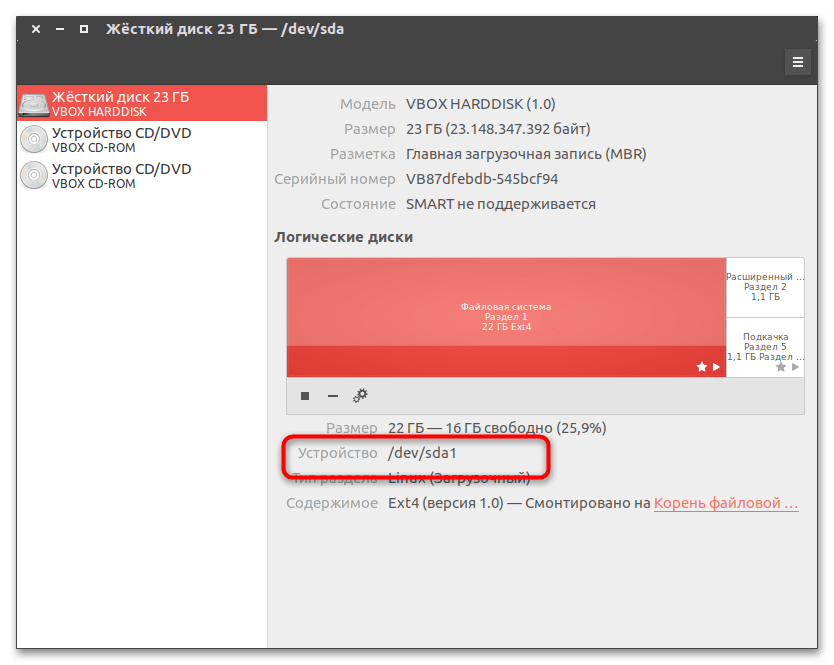

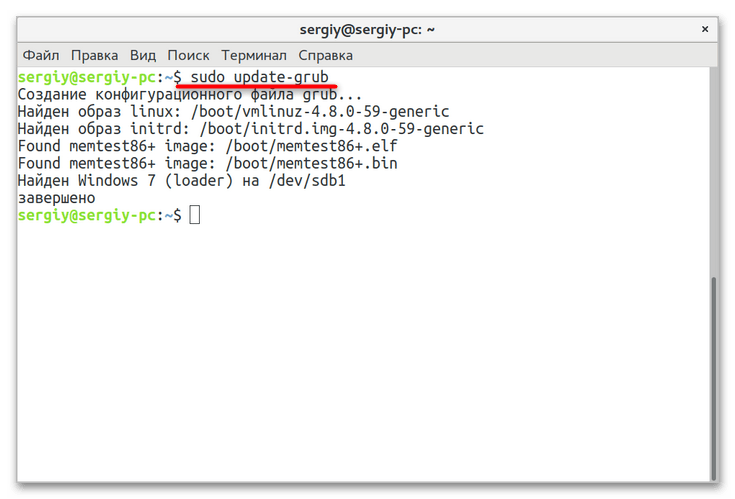
Способ 3: Ручное добавление загрузчика
При использовании первого способа вероятность сходу обнаружить и прописать Windows 10 в линуксовый загрузчик довольно невелика. Более сложным, но и более эффективным способом восстановления записи Windows 10 в загрузочном меню Grub является ручное добавление. Способ универсальный, использовать его можно не только при потере Windows 10, но и других операционных систем Windows.
- Узнайте название раздела с Windows как было показано в первом пункте предыдущего способа.
- Определите UUID раздела, на котором установлена Windows 10, для чего выполните в «Терминале» команду
blkid /dev/sda1, где /dev/sda1 — название раздела с Windows. - Откройте любым текстовым редактором файл
/etc/grub.d/40_customи вставьте в него следующий код, где XXXXXXXXXXXXXXXX — полученный на предыдущем шаге UUID:menuentry "Windows 10" {.
insmod ntfs
set root='(hd0,1)'
search --no-floppy --fs-uuid --set XXXXXXXXXXXXXXXX
chainloader +1
}
Сохраните файл. - Обновите конфигурацию Grub командой
sudo update-grub, перезагрузите компьютер и посмотрите, появилась ли Windows в загрузочном меню Grub.

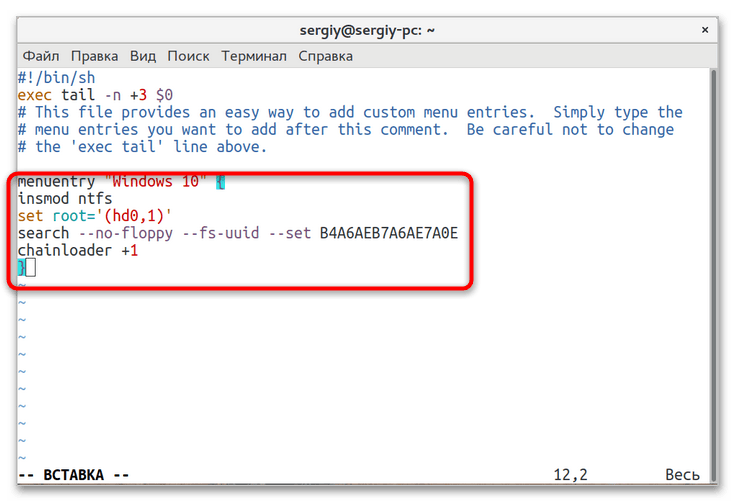
Если восстановить/добавить запись Windows 10 в загрузочное меню «Grub» не удалось, проверьте, не удален ли на диске служебный 100 МБ NTFS-раздел с загрузочными файлами. Если удален, можно будет попробовать его восстановить, но будет гораздо проще переустановить Windows и Linux. В том случае, когда используется «Grub 2» на UEFI, попробуйте включить в BIOS режим «Legacy».
Наша группа в TelegramПолезные советы и помощь
0
1
Здравствуйте, установил вчера кое как арч линукс второй системой на ноут. Теперь не могу запустить windows. Grub не видит её.
В общем устанавливал я не с первого раза, использовал новый установщик archinstall. Попыток наверно 5 сделал и все заканчивались красным страшным текстом на весь монитор, что что то там не получилось, как я понял не получалось efi раздел смонтировать или не туда он монтировался, я испробовал много разных вариантов, которые раньше работали, но сейчас почему то не вышло.
Установил я арч без загрузчика и потом из chroot смонтировал /dev/nvme0n1p1 (efi раздел 4гб) в /boot, и там появилась папка EFI. Далее установил grub (он сам нашел efi раздел) и о чудо все заработало. Но в grub нет windows. Погуглил я и не нашел решения моего вопроса, везде советуют #grub-mkconfig -o /boot/grub/grub.cfg, но grub.cfg у меня нет в системе в принципе.
Вот дерево /boot:
/boot
├── EFI
│ ├── arch
│ ├── Boot
│ │ └── bootx64.efi
│ ├── grub
│ │ └── grubx64.efi
│ ├── Lenovo
│ │ └── BIOS
│ │ └── SelfHealing.fd
│ └── Microsoft
│ ├── Boot
│ │ ├── BCD
│ │ ├── BCD.LOG
│ │ ├── BCD.LOG1
│ │ ├── BCD.LOG2
│ │ ├── bg-BG
│ │ │ ├── bootmgfw.efi.mui
│ │ │ └── bootmgr.efi.mui
│ │ ├── bootmgfw.efi
│ │ ├── bootmgr.efi
│ │ ├── BOOTSTAT.DAT
│ │ ├── boot.stl
│ │ ├── cs-CZ
│ │ │ ├── bootmgfw.efi.mui
│ │ │ ├── bootmgr.efi.mui
│ │ │ └── memtest.efi.mui
│ │ ├── da-DK
│ │ │ ├── bootmgfw.efi.mui
│ │ │ ├── bootmgr.efi.mui
│ │ │ └── memtest.efi.mui
│ │ ├── de-DE
│ │ │ ├── bootmgfw.efi.mui
│ │ │ ├── bootmgr.efi.mui
│ │ │ └── memtest.efi.mui
│ │ ├── el-GR
│ │ │ ├── bootmgfw.efi.mui
│ │ │ ├── bootmgr.efi.mui
│ │ │ └── memtest.efi.mui
│ │ ├── en-GB
│ │ │ ├── bootmgfw.efi.mui
│ │ │ └── bootmgr.efi.mui
│ │ ├── en-US
│ │ │ ├── bootmgfw.efi.mui
│ │ │ ├── bootmgr.efi.mui
│ │ │ └── memtest.efi.mui
│ │ ├── es-ES
│ │ │ ├── bootmgfw.efi.mui
│ │ │ ├── bootmgr.efi.mui
│ │ │ └── memtest.efi.mui
│ │ ├── es-MX
│ │ │ ├── bootmgfw.efi.mui
│ │ │ └── bootmgr.efi.mui
│ │ ├── et-EE
│ │ │ ├── bootmgfw.efi.mui
│ │ │ └── bootmgr.efi.mui
│ │ ├── fi-FI
│ │ │ ├── bootmgfw.efi.mui
│ │ │ ├── bootmgr.efi.mui
│ │ │ └── memtest.efi.mui
│ │ ├── Fonts
│ │ │ ├── chs_boot.ttf
│ │ │ ├── cht_boot.ttf
│ │ │ ├── jpn_boot.ttf
│ │ │ ├── kor_boot.ttf
│ │ │ ├── malgun_boot.ttf
│ │ │ ├── malgunn_boot.ttf
│ │ │ ├── meiryo_boot.ttf
│ │ │ ├── meiryon_boot.ttf
│ │ │ ├── msjh_boot.ttf
│ │ │ ├── msjhn_boot.ttf
│ │ │ ├── msyh_boot.ttf
│ │ │ ├── msyhn_boot.ttf
│ │ │ ├── segmono_boot.ttf
│ │ │ ├── segoen_slboot.ttf
│ │ │ ├── segoe_slboot.ttf
│ │ │ └── wgl4_boot.ttf
│ │ ├── fr-CA
│ │ │ ├── bootmgfw.efi.mui
│ │ │ └── bootmgr.efi.mui
│ │ ├── fr-FR
│ │ │ ├── bootmgfw.efi.mui
│ │ │ ├── bootmgr.efi.mui
│ │ │ └── memtest.efi.mui
│ │ ├── hr-HR
│ │ │ ├── bootmgfw.efi.mui
│ │ │ └── bootmgr.efi.mui
│ │ ├── hu-HU
│ │ │ ├── bootmgfw.efi.mui
│ │ │ ├── bootmgr.efi.mui
│ │ │ └── memtest.efi.mui
│ │ ├── it-IT
│ │ │ ├── bootmgfw.efi.mui
│ │ │ ├── bootmgr.efi.mui
│ │ │ └── memtest.efi.mui
│ │ ├── ja-JP
│ │ │ ├── bootmgfw.efi.mui
│ │ │ ├── bootmgr.efi.mui
│ │ │ └── memtest.efi.mui
│ │ ├── kd_02_10df.dll
│ │ ├── kd_02_10ec.dll
│ │ ├── kd_02_1137.dll
│ │ ├── kd_02_14e4.dll
│ │ ├── kd_02_15b3.dll
│ │ ├── kd_02_1969.dll
│ │ ├── kd_02_19a2.dll
│ │ ├── kd_02_1af4.dll
│ │ ├── kd_02_8086.dll
│ │ ├── kd_07_1415.dll
│ │ ├── kd_0C_8086.dll
│ │ ├── kdnet_uart16550.dll
│ │ ├── kdstub.dll
│ │ ├── ko-KR
│ │ │ ├── bootmgfw.efi.mui
│ │ │ ├── bootmgr.efi.mui
│ │ │ └── memtest.efi.mui
│ │ ├── lt-LT
│ │ │ ├── bootmgfw.efi.mui
│ │ │ └── bootmgr.efi.mui
│ │ ├── lv-LV
│ │ │ ├── bootmgfw.efi.mui
│ │ │ └── bootmgr.efi.mui
│ │ ├── memtest.efi
│ │ ├── nb-NO
│ │ │ ├── bootmgfw.efi.mui
│ │ │ ├── bootmgr.efi.mui
│ │ │ └── memtest.efi.mui
│ │ ├── nl-NL
│ │ │ ├── bootmgfw.efi.mui
│ │ │ ├── bootmgr.efi.mui
│ │ │ └── memtest.efi.mui
│ │ ├── pl-PL
│ │ │ ├── bootmgfw.efi.mui
│ │ │ ├── bootmgr.efi.mui
│ │ │ └── memtest.efi.mui
│ │ ├── pt-BR
│ │ │ ├── bootmgfw.efi.mui
│ │ │ ├── bootmgr.efi.mui
│ │ │ └── memtest.efi.mui
│ │ ├── pt-PT
│ │ │ ├── bootmgfw.efi.mui
│ │ │ ├── bootmgr.efi.mui
│ │ │ └── memtest.efi.mui
│ │ ├── qps-ploc
│ │ │ └── memtest.efi.mui
│ │ ├── Resources
│ │ │ ├── bootres.dll
│ │ │ ├── en-US
│ │ │ │ └── bootres.dll.mui
│ │ │ └── ru-RU
│ │ │ └── bootres.dll.mui
│ │ ├── ro-RO
│ │ │ ├── bootmgfw.efi.mui
│ │ │ └── bootmgr.efi.mui
│ │ ├── ru-RU
│ │ │ ├── bootmgfw.efi.mui
│ │ │ ├── bootmgr.efi.mui
│ │ │ └── memtest.efi.mui
│ │ ├── sk-SK
│ │ │ ├── bootmgfw.efi.mui
│ │ │ └── bootmgr.efi.mui
│ │ ├── sl-SI
│ │ │ ├── bootmgfw.efi.mui
│ │ │ └── bootmgr.efi.mui
│ │ ├── sr-Latn-RS
│ │ │ ├── bootmgfw.efi.mui
│ │ │ └── bootmgr.efi.mui
│ │ ├── sv-SE
│ │ │ ├── bootmgfw.efi.mui
│ │ │ ├── bootmgr.efi.mui
│ │ │ └── memtest.efi.mui
│ │ ├── tr-TR
│ │ │ ├── bootmgfw.efi.mui
│ │ │ ├── bootmgr.efi.mui
│ │ │ └── memtest.efi.mui
│ │ ├── uk-UA
│ │ │ ├── bootmgfw.efi.mui
│ │ │ └── bootmgr.efi.mui
│ │ ├── winsipolicy.p7b
│ │ ├── zh-CN
│ │ │ ├── bootmgfw.efi.mui
│ │ │ ├── bootmgr.efi.mui
│ │ │ └── memtest.efi.mui
│ │ └── zh-TW
│ │ ├── bootmgfw.efi.mui
│ │ ├── bootmgr.efi.mui
│ │ └── memtest.efi.mui
│ └── Recovery
│ ├── BCD
│ ├── BCD.LOG
│ ├── BCD.LOG1
│ └── BCD.LOG2
└── System Volume Information
51 directories, 142 files
Вот вывод fdisk -l:
Disk /dev/nvme0n1: 953.87 GiB, 1024209543168 bytes, 2000409264 sectors
Disk model: SAMSUNG MZVLB1T0HBLR-000L2
Units: sectors of 1 * 512 = 512 bytes
Sector size (logical/physical): 512 bytes / 512 bytes
I/O size (minimum/optimal): 512 bytes / 512 bytes
Disklabel type: gpt
Disk identifier: 406BE08F-2983-4B8D-976D-A6BB8EE68842
Device Start End Sectors Size Type
/dev/nvme0n1p1 2048 8194047 8192000 3.9G EFI System
/dev/nvme0n1p2 8194048 8226815 32768 16M Microsoft reserved
/dev/nvme0n1p3 8226816 928724961 920498146 438.9G Microsoft basic data
/dev/nvme0n1p4 928724992 929791999 1067008 521M Windows recovery environment
/dev/nvme0n1p6 937984000 2000408575 1062424576 506.6G Linux filesystem
Я допускаю, что я рукожоп и криво установил grub, но даже теперь не знаю что делать, нужно что бы в grub был выбор windows и arch. Хелп!

One of the issues I encountered after dual booting Windows with Linux is the missing Windows entry from the grub menu.
Here’s the scenario. Windows was present on the computer. I installed CachyOS alongside Windows. I selected to install the Grub bootloader that allows booting into Linux, Windows (and any other OS present on the system) along with the option to access UEFI.
Only this time, Grub did not show Windows in the menu 😔
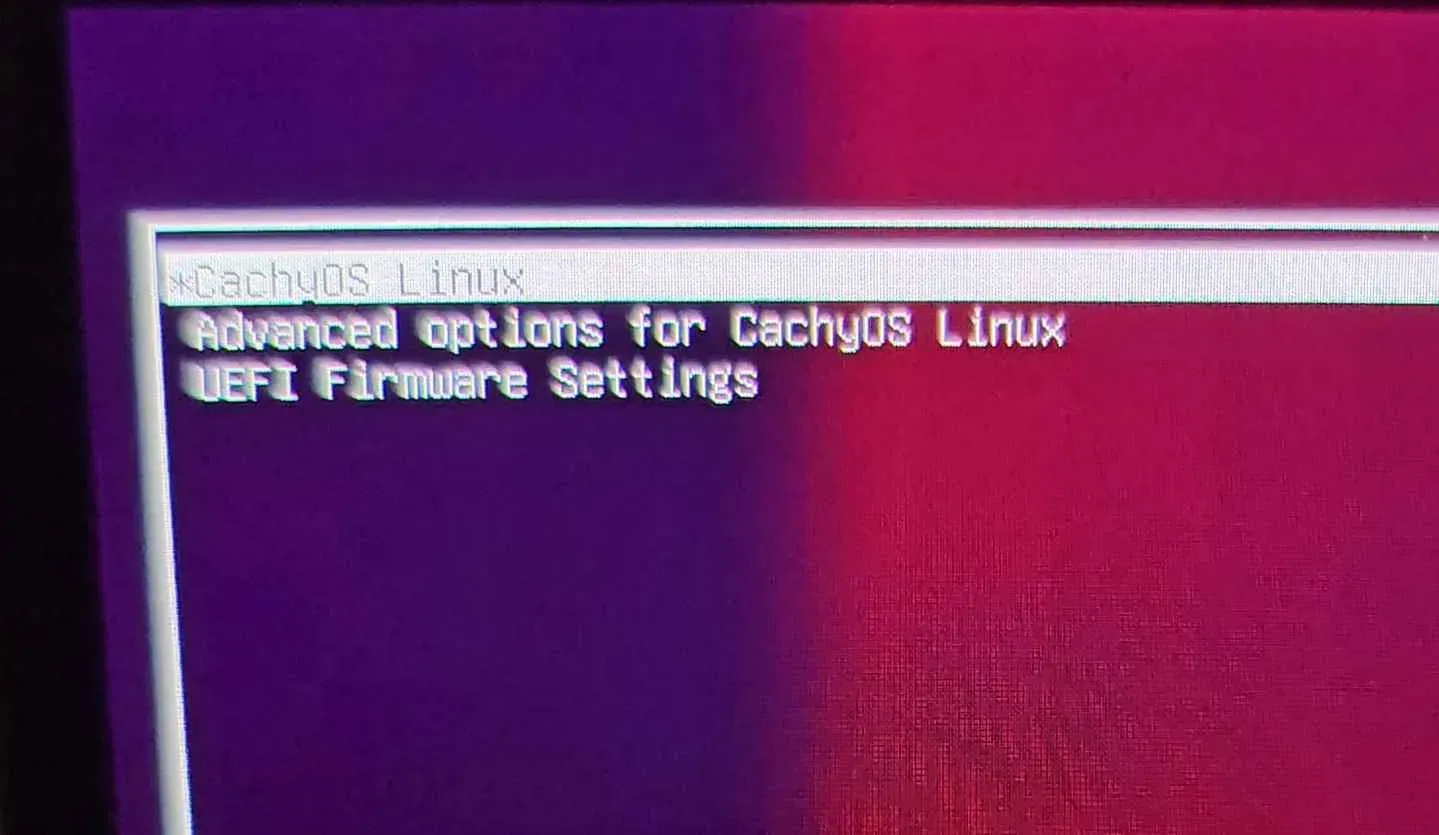
That was disappointing but not surprising because I am aware that this is a feature.
Let me show you how you can fix this by enabling os-prober feature in Grub and then updating it.
Step 1: Enable os-prober in grub
Grub config file is located at /etc/default/grub. If you open it via Nano or some editor, you’ll see at the end of this file that os-prober is disabled by default sighting security reasons.
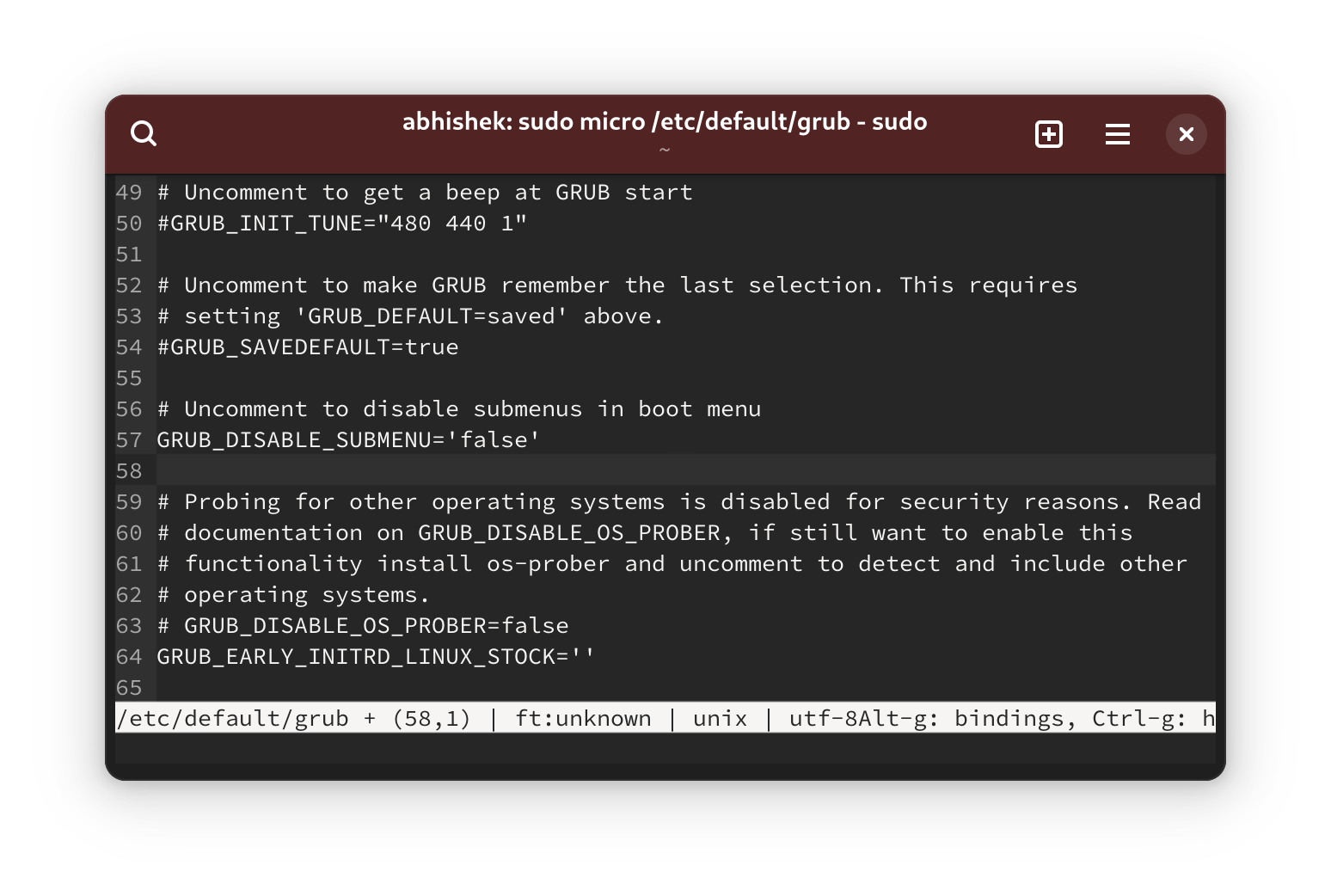
If you are familiar with any terminal-based text editor, use it to uncomment the line # GRUB_DISABLE_OS_PROBER=false by removing the # at the beginning of the line.
However, if you are absolutely new to the command line, you can use this command in the terminal:
echo "GRUB_DISABLE_OS_PROBER=false" | sudo tee -a /etc/default/grubIt will ask for your password. It should be the same account password you use to log in to the system.
🚧
When you type the password in Linux terminal, nothing is reflected on the screen. It feels as if your system is hanged, as there is no visible feedback. Don’t worry. It’s a security feature and most Linux terminals won’t even show asterisks (*) as you enter the password. Just type it in and enter.
With os-prober enabled, Grub will look for the presence of other operating systems in EFI folder and will add them in the bootloader menu.
There is one little problem. The config changes won’t take place unless you update grub.
Step 2: Update grub
On Ubuntu and some other distributions, there is a dedicated command to update grub:
sudo update-grubHowever, on Arch and some other distributions, you’ll end up with update-grub command not found error.
That’s because update-grub is not a standard command. It is just la stub for this command:
sudo grub-mkconfig -o /boot/grub/grub.cfgRun the above command if your system doesn’t have update-grub.
It should show an output like this:
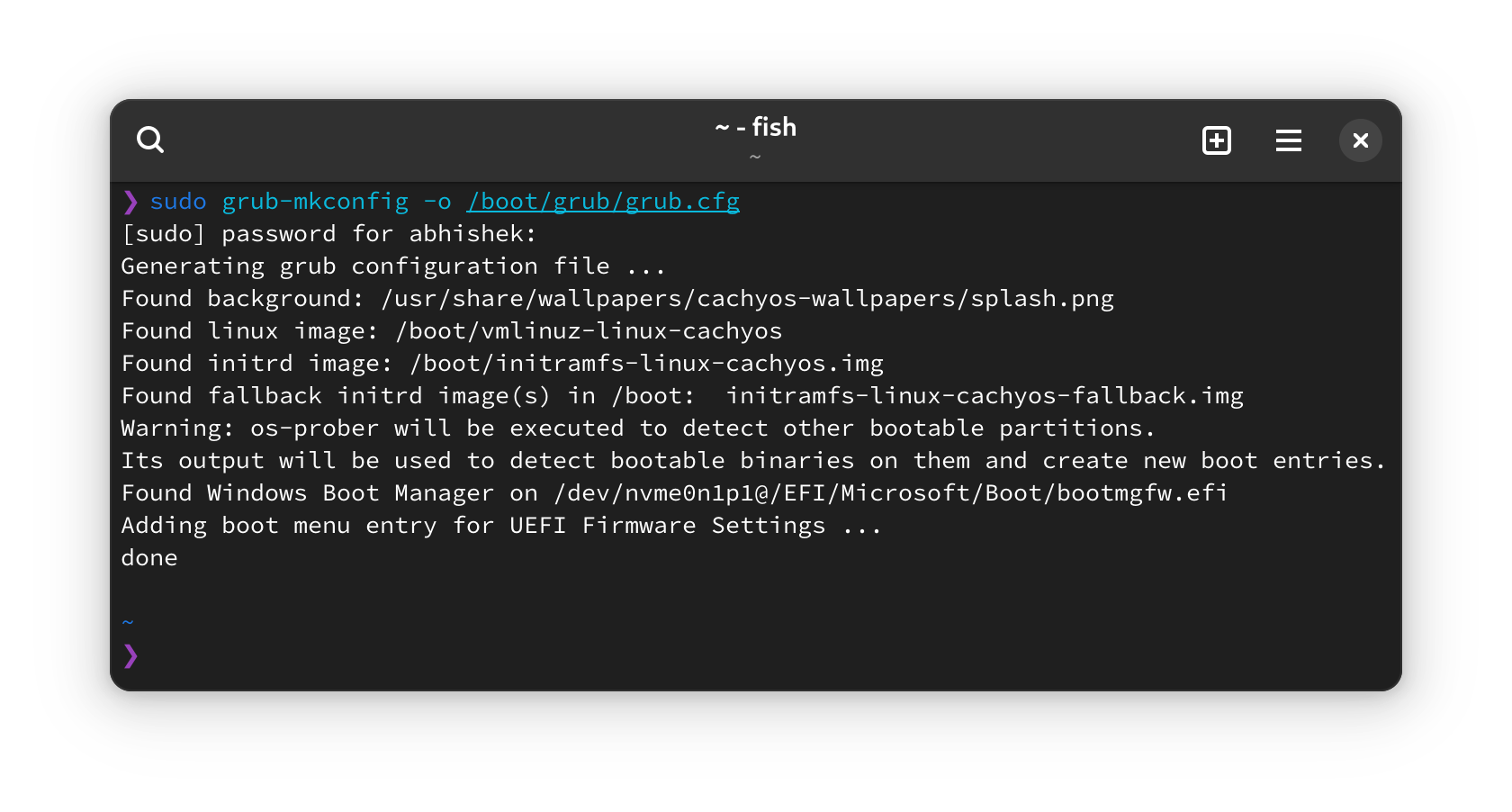
And as you can see in the above output, grub is probing for other OS and has found Windows boot manager. This is an indication that when you reboot the system, grub should show Windows in the available option.
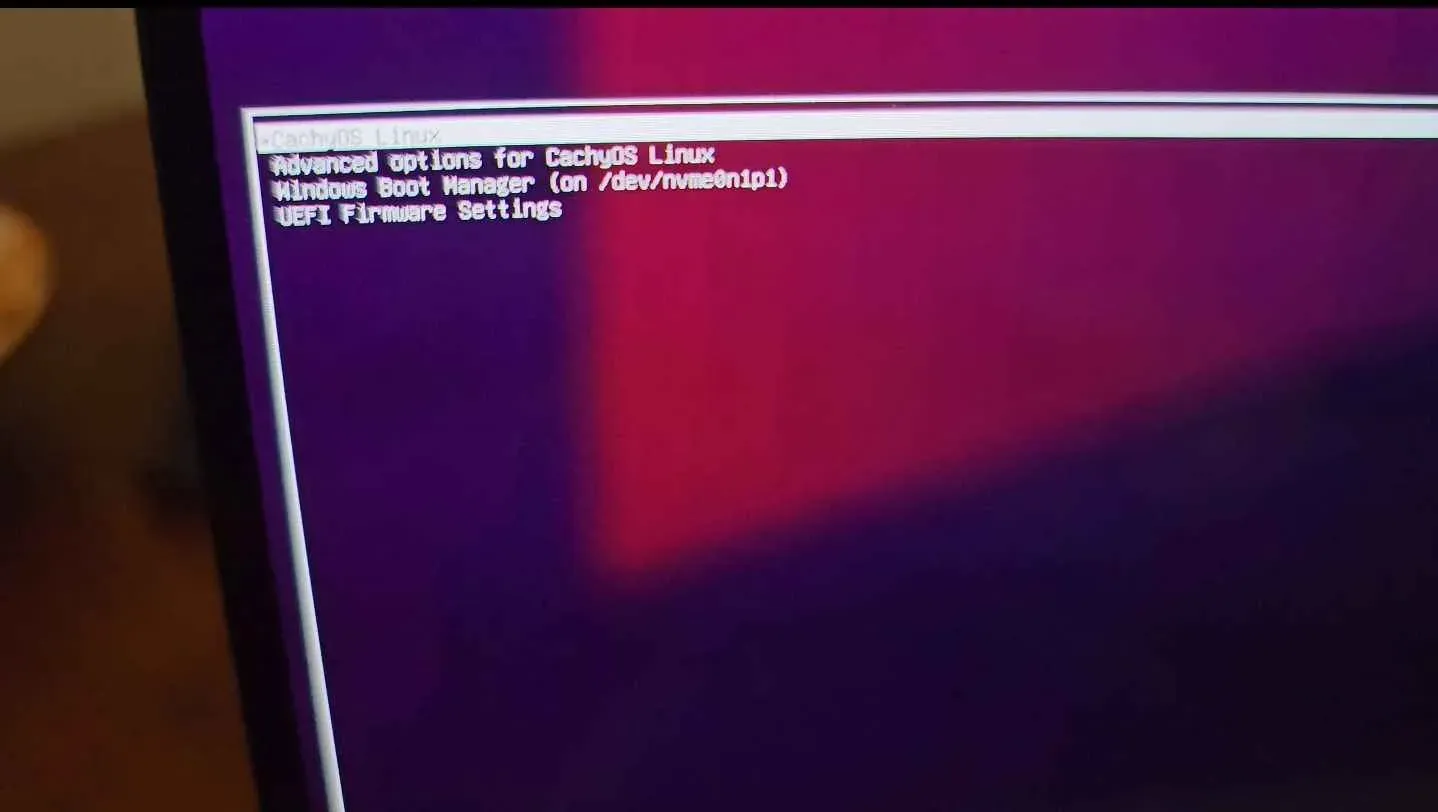
Still no Windows boot manager?
See, this method only works when dual boot succeeded properly and you have all EFI settings located in the same folder under the same ESP partition.
If that’s not the case, you could try accessing the UEFI settings, go to boot order. Windows boot manager should be present there and if you move it up the order, you can boot from it into Windows.
This is not the most convenient option, I understand but it’s a workaround until you figure out why Grub bootloader could not see Windows.
💡 Bonus tip: The time synchronization issue
Since we are discussing dual booting Windows and Linux, let me share another potential issue you’ll encounter. You’ll notice that system time changes when you switch between Windows and Linux. You can fix it, if you want.
[Solved] Wrong Time in Windows 10 After Dual Boot With Linux
If you dual boot Windows and Linux, you’ll notice that often one of them shows incorrect time. Here’s why that happens and what you can do to fix it.
It’s FOSSAbhishek Prakash

💬 I hope this little trick helps you get a better dual booting experience. Let me know in the comments if you were able to get Windows back in Grub.
About the author
Abhishek Prakash
Created It’s FOSS 11 years ago to share my Linux adventures. Have a Master’s degree in Engineering and years of IT industry experience. Huge fan of Agatha Christie detective mysteries 🕵️♂️
#1 2022-02-13 18:00:28
- mohammadreza99a
- Member
- Registered: 2022-02-13
- Posts: 10
Grub does not detect Windows UEFI but efibootmgr finds it
This problem is getting kind of repetitive but I couldn’t actually find a solution to my specific problem. I have installed Arch along side Windows and I have made a FAT32 partition which host Grub and Windows boot loader. The problem is that when I run efibootmgr, the Windows shows up but when I run os-prober, there is nothing and hence my grub can’t detect Windows boot loader. I can boot into Windows only if I put my BIOS priority to Windows. I have checked and I have Windows installed with UEFI. Does anybody know what could be the cause of this problem?
Here are some outputs.
For efibootmgr I get:
BootCurrent: 0001
Timeout: 0 seconds
BootOrder: 2001,0001,0003,2002,2003
Boot0001* Arch_Linux HD(1,GPT,576e6cae-b67b-584b-886d-aa127636a7cc,0x800,0x82000)/File(\EFI\Arch_Linux\grubx64.efi)
Boot0003* Windows Boot Manager HD(1,GPT,576e6cae-b67b-584b-886d-aa127636a7cc,0x800,0x82000)/File(\EFI\Microsoft\Boot\bootmgfw.efi)RC
Boot2001* EFI USB Device RC
Boot2002* EFI DVD/CDROM RC
Boot2003* EFI Network RC For lsblk I get:
NAME MAJ:MIN RM SIZE RO TYPE MOUNTPOINTS
nvme0n1 259:0 0 953.9G 0 disk
├─nvme0n1p1 259:1 0 260M 0 part /boot/efi
├─nvme0n1p2 259:2 0 300.6G 0 part /run/media/mohammadreza/Windows
├─nvme0n1p3 259:3 0 251G 0 part /run/media/mohammadreza/Partition1
├─nvme0n1p4 259:4 0 151G 0 part /run/media/mohammadreza/Partition2
├─nvme0n1p5 259:5 0 150G 0 part /
├─nvme0n1p6 259:6 0 93G 0 part /home
└─nvme0n1p7 259:7 0 8G 0 part [SWAP]#3 2022-02-13 22:50:23
- mohammadreza99a
- Member
- Registered: 2022-02-13
- Posts: 10
Re: Grub does not detect Windows UEFI but efibootmgr finds it
os-prober was enabled by default in /etc/default/grub. I have tried to add manually the Windows boot loader to grub but it does not work. Could it be related to some kind of mount issues?
#4 2022-02-15 06:37:14
- Head_on_a_Stick
- Member
- From: The Wirral
- Registered: 2014-02-20
- Posts: 8,842
- Website
Re: Grub does not detect Windows UEFI but efibootmgr finds it
How exactly did you attempt to manually add the Windows menuentry? Please post the configuration file that was added or edited and also the full content of /boot/grub/grub.cfg,
Please also share the output of
#5 2022-02-17 11:35:31
- mohammadreza99a
- Member
- Registered: 2022-02-13
- Posts: 10
Re: Grub does not detect Windows UEFI but efibootmgr finds it
Here is the output of
/dev/nvme0n1p7: UUID="522fb482-ee75-40c8-9819-d0078a04c71f" TYPE="swap" PARTUUID="443d2b6c-d02d-564b-ac4c-38062f147832"
/dev/nvme0n1p5: UUID="fc20a978-2012-456d-8a38-debbddc18320" BLOCK_SIZE="4096" TYPE="ext4" PARTUUID="260fd788-e554-554d-9659-cec33efe8f16"
/dev/nvme0n1p3: LABEL="Partition1" BLOCK_SIZE="512" UUID="A4EC3CE6EC3CB500" TYPE="ntfs" PARTLABEL="Basic data partition" PARTUUID="87f2f298-8c1e-41b8-9d28-3d65efa000cb"
/dev/nvme0n1p1: LABEL_FATBOOT="NO_LABEL" LABEL="NO_LABEL" UUID="E23D-EDCC" BLOCK_SIZE="512" TYPE="vfat" PARTUUID="576e6cae-b67b-584b-886d-aa127636a7cc"
/dev/nvme0n1p6: UUID="0e15e6f2-5842-4f47-a24e-b04c51f1f07e" BLOCK_SIZE="4096" TYPE="ext4" PARTUUID="8e420e0c-19e6-6048-a0f8-0d79e82fa411"
/dev/nvme0n1p4: LABEL="Partition2" BLOCK_SIZE="512" UUID="A0507F78507F53CE" TYPE="ntfs" PARTLABEL="Basic data partition" PARTUUID="756fa30e-9fa5-42c1-88f5-4843d5e30960"
/dev/nvme0n1p2: LABEL="Windows" BLOCK_SIZE="512" UUID="9E9044E49044C50D" TYPE="ntfs" PARTLABEL="Basic data partition" PARTUUID="6e3de74a-3ed0-4bcb-a711-acf4adb4f13b"To add the entry menu for windows, I put blew code into
:
#!/bin/sh
exec tail -n +3 $0
# This file provides an easy way to add custom menu entries. Simply type the
# menu entries you want to add after this comment. Be careful not to change
# the 'exec tail' line above.
if [ "${grub_platform}" == "efi" ]; then
menuentry "Microsoft Windows Vista/7/8/8.1 UEFI/GPT" {
insmod part_gpt
insmod fat
insmod chain
search --no-floppy --fs-uuid --set=root $hints_string $fs_uuid
chainloader /boot/efi/EFI/Microsoft/Boot/bootmgfw.efi
}
fiand after this i ran the command
and here is the content of my
#
# DO NOT EDIT THIS FILE
#
# It is automatically generated by grub-mkconfig using templates
# from /etc/grub.d and settings from /etc/default/grub
#
### BEGIN /etc/grub.d/00_header ###
insmod part_gpt
insmod part_msdos
if [ -s $prefix/grubenv ]; then
load_env
fi
if [ "${next_entry}" ] ; then
set default="${next_entry}"
set next_entry=
save_env next_entry
set boot_once=true
else
set default="0"
fi
if [ x"${feature_menuentry_id}" = xy ]; then
menuentry_id_option="--id"
else
menuentry_id_option=""
fi
export menuentry_id_option
if [ "${prev_saved_entry}" ]; then
set saved_entry="${prev_saved_entry}"
save_env saved_entry
set prev_saved_entry=
save_env prev_saved_entry
set boot_once=true
fi
function savedefault {
if [ -z "${boot_once}" ]; then
saved_entry="${chosen}"
save_env saved_entry
fi
}
function load_video {
if [ x$feature_all_video_module = xy ]; then
insmod all_video
else
insmod efi_gop
insmod efi_uga
insmod ieee1275_fb
insmod vbe
insmod vga
insmod video_bochs
insmod video_cirrus
fi
}
if [ x$feature_default_font_path = xy ] ; then
font=unicode
else
insmod part_gpt
insmod ext2
search --no-floppy --fs-uuid --set=root fc20a978-2012-456d-8a38-debbddc18320
font="/usr/share/grub/unicode.pf2"
fi
if loadfont $font ; then
set gfxmode=auto
load_video
insmod gfxterm
set locale_dir=$prefix/locale
set lang=en_US
insmod gettext
fi
terminal_input console
terminal_output gfxterm
insmod part_gpt
insmod ext2
search --no-floppy --fs-uuid --set=root fc20a978-2012-456d-8a38-debbddc18320
insmod gfxmenu
loadfont ($root)/usr/share/grub/themes/Vimix/dejavu_32.pf2
loadfont ($root)/usr/share/grub/themes/Vimix/dejavu_sans_12.pf2
loadfont ($root)/usr/share/grub/themes/Vimix/dejavu_sans_14.pf2
loadfont ($root)/usr/share/grub/themes/Vimix/dejavu_sans_16.pf2
loadfont ($root)/usr/share/grub/themes/Vimix/dejavu_sans_24.pf2
loadfont ($root)/usr/share/grub/themes/Vimix/dejavu_sans_48.pf2
loadfont ($root)/usr/share/grub/themes/Vimix/terminus-12.pf2
loadfont ($root)/usr/share/grub/themes/Vimix/terminus-14.pf2
loadfont ($root)/usr/share/grub/themes/Vimix/terminus-16.pf2
loadfont ($root)/usr/share/grub/themes/Vimix/terminus-18.pf2
insmod jpeg
insmod png
set theme=($root)/usr/share/grub/themes/Vimix/theme.txt
export theme
if [ x$feature_timeout_style = xy ] ; then
set timeout_style=menu
set timeout=5
# Fallback normal timeout code in case the timeout_style feature is
# unavailable.
else
set timeout=5
fi
### END /etc/grub.d/00_header ###
### BEGIN /etc/grub.d/10_linux ###
menuentry 'Arch Linux' --class arch --class gnu-linux --class gnu --class os $menuentry_id_option 'gnulinux-simple-fc20a978-2012-456d-8a38-debbddc18320' {
load_video
set gfxpayload=keep
insmod gzio
insmod part_gpt
insmod ext2
search --no-floppy --fs-uuid --set=root fc20a978-2012-456d-8a38-debbddc18320
echo 'Loading Linux linux ...'
linux /boot/vmlinuz-linux root=UUID=fc20a978-2012-456d-8a38-debbddc18320 rw quiet resume=UUID=522fb482-ee75-40c8-9819-d0078a04c71f loglevel=3 audit=0
echo 'Loading initial ramdisk ...'
initrd /boot/intel-ucode.img /boot/amd-ucode.img /boot/initramfs-linux.img
}
submenu 'Advanced options for Arch Linux' $menuentry_id_option 'gnulinux-advanced-fc20a978-2012-456d-8a38-debbddc18320' {
menuentry 'Arch Linux, with Linux linux' --class arch --class gnu-linux --class gnu --class os $menuentry_id_option 'gnulinux-linux-advanced-fc20a978-2012-456d-8a38-debbddc18320' {
load_video
set gfxpayload=keep
insmod gzio
insmod part_gpt
insmod ext2
search --no-floppy --fs-uuid --set=root fc20a978-2012-456d-8a38-debbddc18320
echo 'Loading Linux linux ...'
linux /boot/vmlinuz-linux root=UUID=fc20a978-2012-456d-8a38-debbddc18320 rw quiet resume=UUID=522fb482-ee75-40c8-9819-d0078a04c71f loglevel=3 audit=0
echo 'Loading initial ramdisk ...'
initrd /boot/intel-ucode.img /boot/amd-ucode.img /boot/initramfs-linux.img
}
menuentry 'Arch Linux, with Linux linux (fallback initramfs)' --class arch --class gnu-linux --class gnu --class os $menuentry_id_option 'gnulinux-linux-fallback-fc20a978-2012-456d-8a38-debbddc18320' {
load_video
set gfxpayload=keep
insmod gzio
insmod part_gpt
insmod ext2
search --no-floppy --fs-uuid --set=root fc20a978-2012-456d-8a38-debbddc18320
echo 'Loading Linux linux ...'
linux /boot/vmlinuz-linux root=UUID=fc20a978-2012-456d-8a38-debbddc18320 rw quiet resume=UUID=522fb482-ee75-40c8-9819-d0078a04c71f loglevel=3 audit=0
echo 'Loading initial ramdisk ...'
initrd /boot/intel-ucode.img /boot/amd-ucode.img /boot/initramfs-linux-fallback.img
}
}
### END /etc/grub.d/10_linux ###
### BEGIN /etc/grub.d/20_linux_xen ###
### END /etc/grub.d/20_linux_xen ###
### BEGIN /etc/grub.d/30_os-prober ###
### END /etc/grub.d/30_os-prober ###
### BEGIN /etc/grub.d/30_uefi-firmware ###
menuentry 'UEFI Firmware Settings' $menuentry_id_option 'uefi-firmware' {
fwsetup
}
### END /etc/grub.d/30_uefi-firmware ###
### BEGIN /etc/grub.d/40_custom ###
# This file provides an easy way to add custom menu entries. Simply type the
# menu entries you want to add after this comment. Be careful not to change
# the 'exec tail' line above.
### END /etc/grub.d/40_custom ###
### BEGIN /etc/grub.d/41_custom ###
if [ -f ${config_directory}/custom.cfg ]; then
source ${config_directory}/custom.cfg
elif [ -z "${config_directory}" -a -f $prefix/custom.cfg ]; then
source $prefix/custom.cfg
fi
### END /etc/grub.d/41_custom ####6 2022-02-17 11:45:14
- V1del
- Forum Moderator
- Registered: 2012-10-16
- Posts: 24,360
Re: Grub does not detect Windows UEFI but efibootmgr finds it
You need to actually write out the entry to standard out e.g.
echo 'menuentry "Microsoft Windows Vista/7/8/8.1 UEFI/GPT" {
insmod part_gpt
insmod fat
insmod chain
search --no-floppy --fs-uuid --set=root $hints_string $fs_uuid
chainloader /EFI/Microsoft/Boot/bootmgfw.efi
}'Note that i dropped the /boot/efi from the chainloader line because you need to write paths relative to the ESP root.
Also grub-mkconfig without the -o argument will write to stdout, make sure you properly write the correct config file as well.
#7 2022-02-17 14:54:52
- mohammadreza99a
- Member
- Registered: 2022-02-13
- Posts: 10
Re: Grub does not detect Windows UEFI but efibootmgr finds it
I did this and the problem is that when I click on the Windows entry in grub menu, it says that this path does not exist. Why this is happening? Because I can enter to Windows if I just change boot orders in my BIOS. Is this happening because the Windows boot loader is not correctly put into the correct path ?
Here is the content of my /boot/ folder:
drwx------ - root 1 Jan 1970 efi
drwxr-xr-x - root 17 Feb 15:51 grub
.rw-r--r-- 51k root 10 Feb 14:22 amd-ucode.img
.rw------- 24M root 16 Feb 22:07 initramfs-linux-fallback.img
.rw------- 6.8M root 16 Feb 22:06 initramfs-linux.img
.rw-r--r-- 4.7M root 8 Feb 22:07 intel-ucode.img
.rw-r--r-- 10M root 16 Feb 22:05 vmlinuz-linuxLast edited by mohammadreza99a (2022-02-17 14:59:10)
#8 2022-02-17 15:14:22
- Head_on_a_Stick
- Member
- From: The Wirral
- Registered: 2014-02-20
- Posts: 8,842
- Website
Re: Grub does not detect Windows UEFI but efibootmgr finds it
V1del wrote:
You need to actually write out the entry to standard out.
No, the stanza can be added directly, as stated on the linked ArchWiki page.
mohammadreza99a wrote:
when I click on the Windows entry in grub menu, it says that this path does not exist.
Please share the updated /boot/grub/grub.cfg that contains the Windows entry.
Did you replace $hints_string & $fs_uuid with the actual, correct string & UUID? The ArchWiki page shows how to do that.
mohammadreza99a wrote:
Is this happening because the Windows boot loader is not correctly put into the correct path ?
Check under /boot/efi and see if /EFI/Mircosoft/Boot/bootmgfw.efi is present. It should be there, the Arch & Windows NVRAM entries are both using the same PARTUUID (/dev/nvme0n1p1).
#9 2022-02-17 17:15:11
- V1del
- Forum Moderator
- Registered: 2012-10-16
- Posts: 24,360
Re: Grub does not detect Windows UEFI but efibootmgr finds it
@HoaS if you directly edit /boot/grub.cfg sure, if you intend /etc/grub.d/40_custom to be picked up by grub-mkconfig you’ll definitely need to echo out the intended text somewhere. But still yes, the correct replacement variables have to be replaced anyway.
#10 2022-02-17 17:23:00
- Head_on_a_Stick
- Member
- From: The Wirral
- Registered: 2014-02-20
- Posts: 8,842
- Website
Re: Grub does not detect Windows UEFI but efibootmgr finds it
V1del wrote:
if you intend /etc/grub.d/40_custom to be picked up by grub-mkconfig you’ll definitely need to echo out the intended text somewhere
Nope:
archie:~$ cat /etc/grub.d/40_custom
#!/bin/sh
exec tail -n +3 $0
# This file provides an easy way to add custom menu entries. Simply type the
# menu entries you want to add after this comment. Be careful not to change
# the 'exec tail' line above.
menuentry "Microsoft Windows Vista/7/8/8.1 UEFI/GPT" {
insmod part_gpt
insmod fat
insmod chain
search --no-floppy --fs-uuid --set=root $hints_string $fs_uuid
chainloader /EFI/Microsoft/Boot/bootmgfw.efi
}
archie:~$ doas grub-mkconfig 2>/dev/null | grep -A6 Vista
menuentry "Microsoft Windows Vista/7/8/8.1 UEFI/GPT" {
insmod part_gpt
insmod fat
insmod chain
search --no-floppy --fs-uuid --set=root $hints_string $fs_uuid
chainloader /EFI/Microsoft/Boot/bootmgfw.efi
}
archie:~$Even 40_custom disagrees with you
#11 2022-02-17 18:42:38
- V1del
- Forum Moderator
- Registered: 2012-10-16
- Posts: 24,360
Re: Grub does not detect Windows UEFI but efibootmgr finds it
I stand corrected
#12 2022-02-17 19:54:06
- mohammadreza99a
- Member
- Registered: 2022-02-13
- Posts: 10
Re: Grub does not detect Windows UEFI but efibootmgr finds it
Head_on_a_Stick wrote:
Did you replace $hints_string & $fs_uuid with the actual, correct string & UUID? The ArchWiki page shows how to do that.
While running grub-probe —target=hints_string /boot/efi/EFI/Microsoft/Boot/bootmgfw.efi in order to get$hints_string, I get this error:
grub-probe: warning: unknown device type nvme0n1.For $fs_uuid I get a response.
I mean this is just a warning but it is weird that there is not any output.
#13 2022-02-17 20:02:39
- mohammadreza99a
- Member
- Registered: 2022-02-13
- Posts: 10
Re: Grub does not detect Windows UEFI but efibootmgr finds it
mohammadreza99a wrote:
Head_on_a_Stick wrote:
Did you replace $hints_string & $fs_uuid with the actual, correct string & UUID? The ArchWiki page shows how to do that.
While running grub-probe —target=hints_string /boot/efi/EFI/Microsoft/Boot/bootmgfw.efi in order to get$hints_string, I get this error:
grub-probe: warning: unknown device type nvme0n1.
So I have a fix for this issus. What i did was to copy the output in the wiki and I changed hd0 to nvme0n1 and I can finally successfully load into Windows from Grub. But the main issus always remains. The fact that os-prober is not able to find Windows loader.
Here is my /etc/grub.d/40_custom for those that might have the same issus:
#!/bin/sh
exec tail -n +3 $0
# This file provides an easy way to add custom menu entries. Simply type the
# menu entries you want to add after this comment. Be careful not to change
# the 'exec tail' line above.
if [ "${grub_platform}" == "efi" ]; then
menuentry "Microsoft Windows Vista/7/8/8.1 UEFI/GPT" {
insmod part_gpt
insmod fat
insmod chain
search --no-floppy --fs-uuid --set=root --hint-bios=hd0,gpt1 --hint-efi=nvme0n1,gpt1 --hint-baremetal=ahci0,gpt1 E23D-EDCC
chainloader /EFI/Microsoft/Boot/bootmgfw.efi
}
fiThank you both for helping me.
Last edited by mohammadreza99a (2022-02-17 20:02:58)
#14 2022-02-17 20:29:41
- Head_on_a_Stick
- Member
- From: The Wirral
- Registered: 2014-02-20
- Posts: 8,842
- Website
Re: Grub does not detect Windows UEFI but efibootmgr finds it
The —hint options are only needed if you have multiple partitions with the same filesystem UUID.
All I have ever needed is
menuentry 'Windows' {
search.fs_uuid $uuid
chainloader /EFI/Microsoft/Boot/bootmgfw.efi
}search.fs_uuid is an alias for search —fs-uuid and the root variable is the presumed default.
|
# |
|
|
Темы: 4 Сообщения: 9 Участник с: 07 августа 2023 |
Всем ку!!! помогите, пожалуйста, поставил дуалбут, а граб Винду не видит…
перепробовал эти гайды: https://lumpics.ru/grub-does-not-see-windows-10/ https://askubuntu.com/questions/216215/invalid-efi-file-path и вроде в меню винда появляется, но либо не грузит, либо пишет «Invalid EFI file path» помогите, прошу… |
|
vasek |
# (отредактировано 1 год, 8 месяцев назад) |
|
Темы: 47 Сообщения: 11922 Участник с: 17 февраля 2013 |
Информации мало, гадать никто не будет … Для начала посмотри этот топик — возможно причина и в os-prober Ошибки не исчезают с опытом — они просто умнеют |
|
arruka |
# |
|
Темы: 4 Сообщения: 9 Участник с: 07 августа 2023 |
решение через os-prober тоже пробовал, но ничего не получилось т_т весь интернет перерыл — ничего не помогает _( однако!!! |
|
zotkindm |
# |
|
Темы: 73 Сообщения: 590 Участник с: 21 мая 2014 |
У всех работает у одного тебя нет. EFI раздел монтировал? |
|
Natrio |
# |
|
Темы: 48 Сообщения: 4771 Участник с: 08 января 2011 |
Для начала надо неплохо было бы выяснить, что за Windows, и загружается ли она из BIOS/UEFI (и жива ли вообще). Видно ли там в вариантах загрузки «Windows boot manager»? Видно ли grub, arch или что-то в этом духе? В каком режиме (BIOS/UEFI) запускается GRUB? Чтобы запустить загрузчик Windows из GRUB, они должны быть одинакового типа (BIOS-BIOS или UEFI-UEFI). |
|
kononow |
# |
|
Темы: 0 Сообщения: 2 Участник с: 23 января 2022 |
До того как в вики появилось я с этим столкнулся: |
|
acid_raccoon |
# |
|
Темы: 10 Сообщения: 111 Участник с: 08 мая 2020 |
Всем привет. Извините что немного не по теме. У кого dualboot win10 и arch в uefi режиме. Поделитесь примером menuentry для win10 из grub.cfg которая создана командой # grub-mkconfig -o /boot/grub/grub.cfg. Спасибо. «Load universe into cannon. Aim at brain. Fire.» © |
|
RusWolf |
# |
|
Темы: 11 Сообщения: 2868 Участник с: 16 июля 2016 |
https://t.me/arch_linuxru |
|
acid_raccoon |
# (отредактировано 1 год, 8 месяцев назад) |
|
Темы: 10 Сообщения: 111 Участник с: 08 мая 2020 |
Судя по этой строчке у тебя общий esp раздел для win и linux, и оба загрузчика находятся на нём. А как chainloader должен выглядеть если win на отдельном диске, со своим esp и bootmgfw.efi не нём. Если записываю так: получаю: «Load universe into cannon. Aim at brain. Fire.» © |
|
RusWolf |
# (отредактировано 1 год, 8 месяцев назад) |
|
Темы: 11 Сообщения: 2868 Участник с: 16 июля 2016 |
Нет. На разных дисках.
Так же:
У тебя ESP раздел, совсем не на третьем разделе, из вывода твоего lsblk -lf. https://t.me/arch_linuxru |
